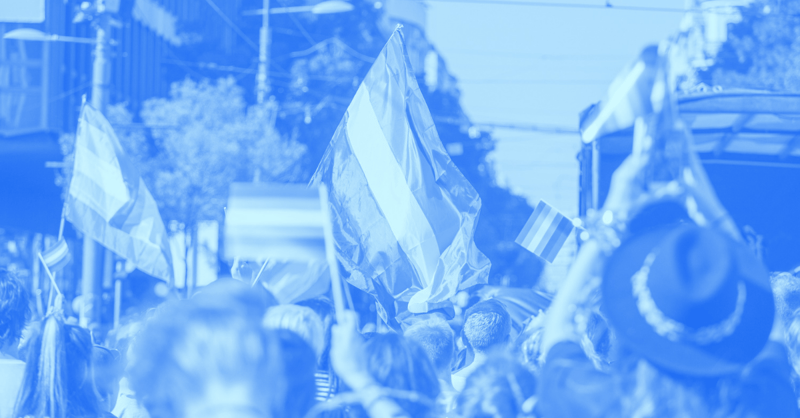
11 MIN READ
Planning for LGBTQ Couples: Distinct Financial Challenges Persist
Three years ago, Obergefell vs. Hodges upended financial planning for LGBTQ couples, legalizing same sex marriage throughout the United States for the first time ever. It was a momentous change, obviously, and now people often ask me if there are any remaining differences between financial planning for LGBTQ and heterosexual couples.
The answer is unequivocally yes. Even post-Obergefell, the LGBTQ community faces a wide array of issues that don’t affect our straight counterparts. Some interesting new studies have highlighted issues unique to the LGBTQ financial experience, as well as key planning issues for these households. Today, I’d like to briefly go over the results and their implications for LGBTQ couples.
The world for the LGBTQ community looks much different now
When I first thought of the idea of starting a financial blog for the LGBTQ community, I came across a study by Prudential that explored “the hopes, dreams and fears of LGBT Americans.” I was so excited to find the report because I’d never seen anything like it that specifically focused on the LGBTQ community. I found the statistics interesting and really useful when I made the pitch to my bosses about starting my blog. Ironically, just in time for the launch of my new business, Prudential offered an update.
The update rightly points out that “the world looks much different today” for the LGBTQ community than their last analysis back in 2012. The Obergefell decision has afforded us access to over 1,100 federal benefits, including filing joint tax returns, putting spouses on health insurance on a pre-tax basis, and spousal protections in the event of death.
Marriage is on the rise
According to the Williams Institute out of the UCLA law school, more same sex couples than ever are choosing to marry. In 2013, the year that the Windsor ruling was issued, only 230,000 same-sex couples — or about one in five— were married. By June 2015, when Obergefell was decided, that number had risen to 390,000 married same-sex couples were married, or 38% of the total. Just four months later, the total had grown again dramatically to 486,000 married couples, representing nearly half (45%)of all same-sex couples. Take a moment to let that sink in — 256,000 same-sex couples married in a little over two years.
Gallup offered additional numbers showing that 49% of same-sex, cohabitating couples were married in 2016 and 61% for 2017. Gallup also estimates that now 10.2% of all LGBTQ adults are married.
The Prudential study also saw a huge increase in the marriage rate of its participants. Married couples represented just 8% of all participants in 2012 and 30% in 2016. In addition, almost half of those respondents said marriage equality had simplified their finances.
Because same sex marriage is so new, it raises some unique planning challenges for LGBTQ couples. I work with a couple in their 50s who have been together for a long time but just recently married. We’ve focused on things like getting on the same page financially, commingling assets and dealing with their taxes — all issues that most heterosexual couples their age have long settled.
And there are additional complexities around LGBTQ adoption, fertility and medical expenses that many straight couples don’t face.
Some Things Have Changed For the Worse
Despite progress in marriage equality, not every aspect of LGBTQ financial planning has gotten better. For instance, here are some negative changes that the Prudential study found.
- Lesbian women earn less than heterosexual women, reporting an average annual salary of $45,606 vs. $51,461. (A difference of $5,855)
- Gay men reported earning an average of $56,936, with heterosexual men earning $83,469. (A difference of $26,533).
LGBTQ respondents surveyed in 2016 are less likely to have started saving or investing for retirement, to have insurance products and to have a will or estate plan than those surveyed in 2012 or general population respondents
- More LGBTQ respondents consider themselves “spenders,”— 48% compared to 32% of the general population. The respondents spending patterns confirmed that they spend more and save less, compared to the general population.
- Overall the LGBT population owned less financial planning products (such as mutual funds, life insurance or will) than the general population.
- 41% of respondents today, compared to 31% in 2012, said they are struggling financially.
These statistics clearly debunk the “Rich Gay Myth“. In addition, they demonstrate a need for more financial progress, especially when it comes to the job front. I’ll discuss the LGBTQ income and wealth gaps for the LGBTQ community more next week.
Currently, there is no comprehensive federal law that protects LGBTQ people from getting fired for their sexual orientation. In fact, the Seventh Circuit Court held that Title VII of the Civil Rights Act does not prohibit sexual orientation discrimination, while the Second Circuit held the opposite view. This inconsistency means state law determines legal protections for LGBTQ citizens. Currently only 22 states have an anti-discrimination statute that includes sexual orientation (two of those states do not include sexual identity, or the “T”) for private employers. You can still be fired in 28 states just for being an LGBTQ individual.
In fact, the appellate courts have been inconsistent on this point. The Seventh Circuit Court held that Title VII of the Civil Rights Act does not prohibit sexual orientation discrimination, while the Second Circuit held the opposite view. This inconsistency means state law determines legal protections for LGBTQ citizens. Currently only 22 states have an anti-discrimination statute that includes sexual orientation (two of those states do not include sexual identity, or the “T”) for private employers. You can still be fired in 28 states just for being an LGBTQ individual.
This lack of legal protection creates job insecurity and pay inequities that our straight counterparts don’t have to confront. As such, we have to prepare differently when it comes for saving for emergencies, being out at work and planning for retirement.
A recent 2018 study conducted by AEGON’s Center for Longevity and Retirement also showed the LGBT workers are more likely than their heterosexual counterparts to have a written plan, yet they are less likely to be saving habitually and at much higher risk of not achieving a “financially secure retirement.” The study concluded, “While LGBT people and heterosexuals share similar retirement aspirations, differences in family circumstance, challenges in the workplace and health issues lead to great vulnerability among LGBT people.”
A look at other aspects of wealth
In addition to job insecurity and income gaps, the LGBTQ community also has some substantial differences in wealth accumulation. According to the Prudential survey, all LGBT respondents had the following amounts of debt (not including mortgage or home equity loans):
- 45% have less than $10,000
- 34% have $10,000 – $50,000
- 21% have over $50,000
Further more the majority of the LGBT population didn’t have fairly standard financial products:
- 40% have a savings account including money market or certificate of deposit
- 35% have an employer-sponsored retirement plan (401k, 403B, 457)
- 18% have an individual IRA that is not employer-sponsored
- 18% have an employer sponsored pension plan
- 15% have mutual funds
- 18% have individual stocks
- 8% have individual bonds
- 42% have life insurance
- 19% have disability insurance
- 10% have long-term care insurance
- 19% have a will or estate plan
These percentages are lower than the general population figures, expect for the individual bond percentages, which were equal. My clients and I focus a lot on education about the importance of these tools and how to use them to their advantage.
There’s Hope
LGBTQ families face a lot of challenges, but good financial advice can help. You just have to find someone you can trust and open up to.
I started my blog and my firm to help LGBTQ individuals learn more about personal finance and to give our community the tools to make progress toward social and economic equality. While planning can’t negate all the social and economic barriers that exists for our community, focusing on the things that we can control will help us thrive rather than tread water. The Prudential survey found that while fewer LGBTQ respondents (versus general population) work with a financial professional, those that did had loftier financial goals, strong financial confidence and more successful saving.
One thing that I really appreciated about Prudential’s survey was it took into account the goals of our community. For example, the LGBTQ respondents were much more likely than the general population respondents to say that they need to gain more knowledge in order to tackle their financial goals. They also mentioned that they didn’t feel fully prepared because they don’t’ know their options, don’t know how best to evaluate their options or don’t know how to get started.
Despite now having full marriage rights, the LGBTQ community has a lot of ground to make up when it comes to succeeding financially. We need to stay informed and help each other succeed.
This article originally appeared on Brian Thompson Financial LLC
The Importance of Pride Month and How it All Got Started, by Brian Thompson
Each June, LGBT Pride Month is celebrated across the country.
I love this time of year — the Pride parties, parades and the overall good energy as people celebrate the LGBT community. I also love to reflect on how far we’ve come and the work still yet to do. We got a huge reminder of what’s at stake for us this past Monday.
The Supreme Court decided in favor of two bakers who refused to bake a wedding cake for a gay couple. While the decision was narrowly tailored and rested on faulty procedure by the Colorado Civil Rights Commission, the two men in this case, Charlie Craig and Dave Mullens, were still victims of discrimination based on their sexual orientation. And because the justices did not decide whether baking a cake is protected speech or address the conflict between freedom of religion and equal protection, we will likely see more cases like this in the future.
This instability and insecurity is why we still celebrate Pride month. According to the 2016/2017 LGBT financial survey, respondents were most likely to be worried about unemployment, inflation and unpaid debts (and rightly so considering LGBTQ individuals can still be fired in 28 states for their sexual orientation). Additionally, a huge pay gap exists between LGBTQ individuals and their heterosexual counterparts. Celebrating Pride month helps us keep vigilant in our fight for equality and helps created much needed support from our allies.
Yet Pride’s meaning can sometimes get lost in the celebration and debauchery. So to start off the month-long celebration, I want to take a step back. Let’s explore the history of Pride month, and specifically the Pride Parades.
The Catalyst
In the early morning of June 28th, 1969, eight officers from the New York City’s Public Morals Division, a unit of the police department, raided the Stonewall Inn, a gay bar in New York City’s Greenwich Village. This raid wasn’t unusual in New York (or many other cities). Back then, the Public Morals Division enforced all laws for vice and gambling, including prostitution, narcotics and homosexuality. Cops could arrest and even force hospitalization of gay people.
On this particular evening, however, the bar patrons fought back. It started when Marsha P. Johnson cried “I got my civil rights!” and threw a shot glass into a mirror (now known as “the Shot Glass that was Heard Around the World”). More and more patrons joined the fight, including people from neighboring bars, and mayhem ensued. Hundreds of people resisted arrest and fought against police oppression. Rioters broke windows, set cars on fire and injured three police officers. The police ended up barricading themselves inside the Stonewall Inn.
New York City’s Tactical Patrol Force intervened, but even they were run out of the neighborhood by the rioters. Things eventually calmed down. But once the word got out about the riots, thousands returned the next night to continue the protest. The protest lasted six days.
Increasing Our Pride
Stonewall was not the start of the LGBTQ movement. LGBTQ activists existed as far back as 1920s. But the rage and fervor caused by the Stonewall riots helped catapult the LGBTQ movement to a new level.
Media coverage of the riots allowed others to see, relate and support those fighting for their rights. Events at Stonewall emboldened others to do what they could to help.
The following year, the anniversary of the Stone Wall riots was marked by demonstrations in New York, Chicago, Los Angeles and San Francisco.
At first, the New York City day of celebration was called “Christopher Street Liberation Day.” In Los Angeles and San Francisco, these events became known as “Gay Freedom Marches,” and the day was called “Gay Freedom Day.” Chicago had Gay Pride Week.
The parades were a mix of politics and celebration. They promoted visibility of the LGBTQ community. They also served as a huge megaphone for the LGBTQ needs and rights — like protection against harassment, raising awareness of the AIDS epidemic or fighting for marriage equality. They gave a growing LGBTQ movement a voice and, as support grew, that voice began to be heard.
The culture shifted in the 1980s, as less radical activists began taking over the march committees in different cities. They dropped “Gay Liberation” and “Gay Freedom” from the names, replacing them with “Gay Pride.”
Gay Rights Today
The first few marches drew only a few hundred people, but the Pride parades today include hundreds of thousands. In fact, the 2013, 2014 and 2015 Pride crowds in Chicago had an estimated one million attendees.
We’ve come a long way from the police brutality and stigmatization of the 1970s. We’ve also made it through the AIDS crisis of the 1980s and 1990s. The parades have long been the voice and coming together of the LGBTQ community to celebrate our lives.
For seven straight years, from 2009 through 2016, President Obama officially declared June as LGBT Pride month. We can get married and legally adopt children in all 50 states.
However, there’s still a ways to go. You can still legally be fired in 28 states for being LGBT. The newest administration has already proven that it does not want to take our rights into consideration, especially when it comes to trans rights. Additionally, we are seeing legislation proposed that could water down our rights, and we aren’t being counted in census.
So, as you go out and celebrate this month, don’t forget to acknowledge the sacrifices of those that came before use. Resisting and protesting works. But progress never is a straight line.
You can find more information from me about the fight for marriage equality here.
I also encourage you to read about other significant LGBTQ people that have helped shaped the movement as we know it.
You should also check out the amazing content that helped create this post:
And lastly, if you’re just looking for some info on LGBT history, check out the following:
How are you going to honor those that helped pave the way for you?
 About the Author
About the Author
Brian Thompson, JD, CFP® is the founder of Brian Thompson Financial LLC. His firm specializes in helping LGBTQ couples set and achieve their goals, protect and grow what they already have and guide them to the lifestyle that brings them fulfillment and happiness. Brian also serves as President of XYPN's Diversity Committee, whose mission is to lead the industry by attracting, supporting, and developing a diverse group of Financial Planners so our community can embrace our differences and make us all more knowledgeable, more accepting, and better people.
Do you know XYPN advisors provide virtual services? They can work with clients in any state! View Brian's profile


 About the Author
About the Author

